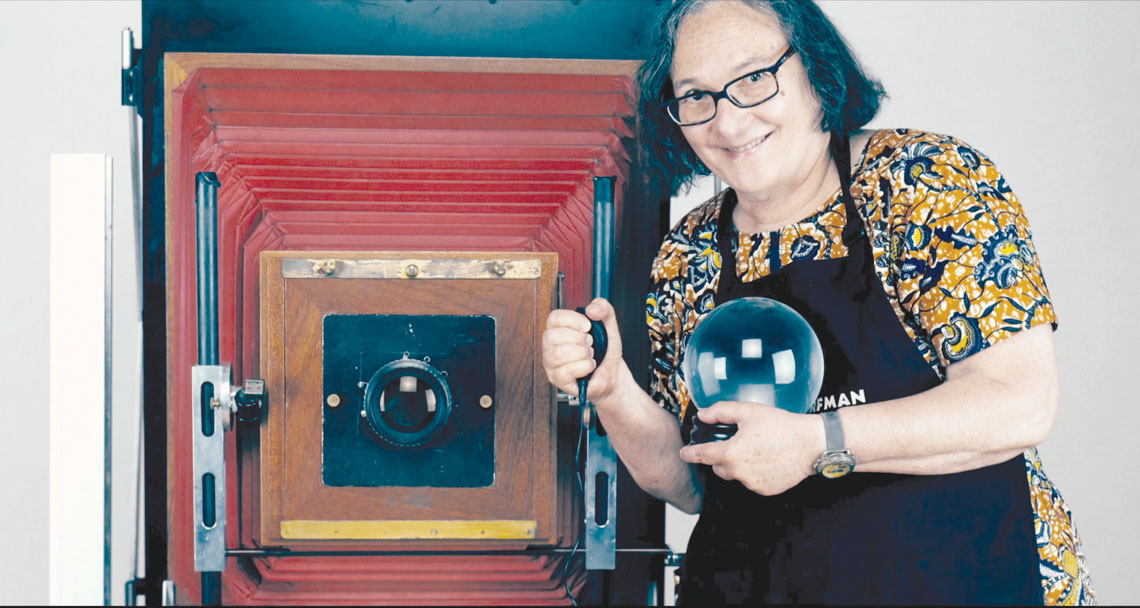 Elsa Dorfman. Photo courtesy of NEON
Elsa Dorfman. Photo courtesy of NEON Before digital photography made selfie images just a cellphone click away, Polaroid filled the desire for immediate gratification with its portable instant cameras.
But for Elsa Dorfman, Polaroid means the 20×24 camera, a 235-pound behemoth that produces instant images 20 inches by 24 inches. She has used it to photograph the famous (including Bob Dylan and her good friend, the late beat poet Allen Ginsberg) and the nonfamous in her Cambridge, Mass., studio.
Her work is now the subject of “The B-Side: Elsa Dorfman’s Portrait Photography,” by documentary filmmaker Errol Morris, best known for “The Thin Blue Line” and the Oscar-winning “The Fog of
War: Eleven Lessons from the Life of Robert S. McNamara.”
“There’s something about the experience of having your picture taken by Elsa — being part of her world, going to her studio, having your photo taken and watching it develop,” Morris said.
He and his family have posed for Dorfman many times since they first met her 26 years ago — after Morris’ wife, Julia, commissioned a portrait of their 4-year-old son as a Father’s Day gift. They became friends, and Morris floated the idea of making a film about her. Dorfman didn’t take him seriously.
“I’d say, ‘Sure, whatever.’ I blew it off,” Dorf-man said. “Then one day, he said, ‘I have the crew for next week.’ ”
In early 2016, Morris interviewed her as she talked about her life and displayed her archive.
“Making the movie was like psychoanalysis,” Dorfman said. “It made me think about the different periods in my life.”
Now 80, the “not observant but very Jewish” Dorfman always was a people watcher, a self-described “starer” and, at times, an eavesdropper. As a teenage exchange student, she chronicled a 1954 trip to Germany with a Kodak Pony that friends gave her, but she didn’t start taking photos professionally until 10 years later, when she received a Hasselblad at the age of 27. In 1976, Polaroid produced just five 20×24 cameras, and after a few years of pleading, she got to use one for the first time in 1980. It was love at first snap.
“This camera was very magnetic,” she said, comparing the immediate attraction to falling in love with her husband, Harvey, a defense attorney, when they met in 1967. She also loved that it freed her from the time-consuming darkroom, because she was a busy mom to her toddler son, Isaac, now 40.
“She kept making these Polaroids, not getting a tremendous amount of attention as an artist, selling them at modest prices and collecting this amazing array of photographs,” Morris said.
The film’s title has both a literal and metaphorical meaning, he said. In her work, Dorfman would take two photographs and have the buyer choose one; she would keep the other, or B-side.
But like a 45-rpm record, Morris said, a B-side is “something discarded, rejected. Elsa was a B-side artist. She was never really given her due, never taken seriously, certainly not by Polaroid. The irony, of course, is the B-sides are some of her best photographs.”
Morris owns many photos that Dorfman has taken of his family, but not all are on display in his Cambridge office or his homes there and in Vermont because the prints are fragile. Too much light and too much or too little humidity can damage them. That’s why Dorfman stores her archive in the dark.
Today, she continues to occasionally shoot with the 20×24 camera — at $5,000 and up per session — but film for it is rare and of questionable quality as it degrades over time. She owns a digital camera, “but I never use it,” she said. “To me, a photograph is something you have in your hand, you put on your wall.”
As for the future of her archive, she said she doesn’t want her son and grandchildren to be burdened by having to care for it but probably will leave it to them. “And they can decide what to do with it,” she said.
Morris said that he saw Dorfman as “a kindred spirit” who shares an interest in people presenting themselves to and being recorded by a camera. He compared “The B-Side” to his documentary “Fast, Cheap & Out of Control,” which profiled people with unusual careers.
Ironically, although he’s known for his documentaries, he doesn’t particularly like the genre and said he got started making them by “happenstance.”
Raised by a Polish-Jewish single mother, a Juilliard-trained pianist, in Hewlett, N.Y., Morris wanted to be a writer but got interested in film at the University of Wisconsin. As a graduate student, he met filmmakers Wim Wenders and Werner Herzog at the Pacific Film Archive in Berkeley and worked with Herzog on his film “Stroszek” in 1976. He released his first documentary, “Gates of Heaven,” about the pet cemetery business, two years later.
To a resumé that now includes features, shorts, commercials and TV series, Morris will add “Wormwood,” a Netflix series starring Peter Sarsgaard and Molly Parker, and may go to Russia to make a film about Mikhail Gorbachev. “Nazis always interest me,” he said, mentioning a possible project about Hitler’s chief architect, Albert Speer.
Morris’ personal agenda includes a trip to Israel; he hasn’t been back since his son’s bar mitzvah. “I’m very proud to be a Jew,” he said.
The director hopes “The B-Side” will bring Dorfman the recognition she and her work deserve. “She’s a fabulous underdog who worked hard, is unpretentious and yet has created work that is deeply interesting and profound,” Morris said. “To know Elsa is to love Elsa.”
“The B-Side” is playing at the Laemmle Royal in Los Angeles and opens July 7 at the Laemmle Playhouse in Pasadena and Laemmle Town Center 5 in Encino.






















 More news and opinions than at a Shabbat dinner, right in your inbox.
More news and opinions than at a Shabbat dinner, right in your inbox.